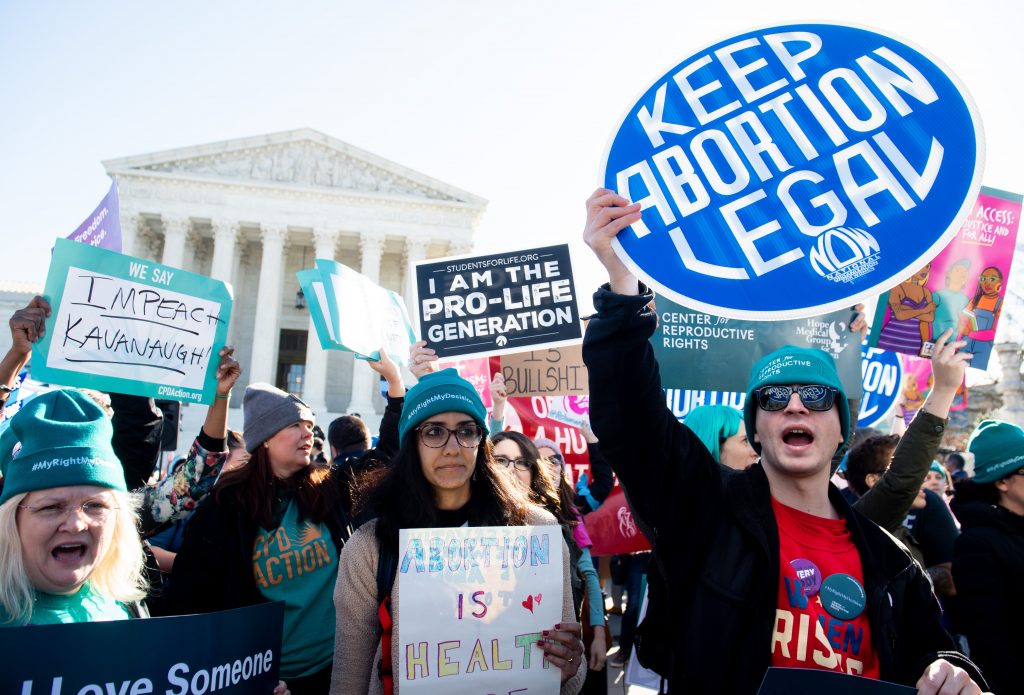- The 1973 landmark case Roe v. Wade established the constitutional right to an abortion in the US.
- The Supreme Court appears poised to overturn that decision, a leaked draft opinion indicated.
- If overturned, states and the federal government will be free to legislate abortion.
Abortion is a constitutionally protected right in the US and has been since 1973, but a Supreme Court draft opinion leaked last week suggests that could soon change.
If the court overturns Roe, as it appears poised to do, abortion will no longer be a federally protected right. Here's what that means.
Before Roe v. Wade
Prior to 1973, abortion rights were not protected by the federal government. States were free to legislate abortion as they pleased, and at one point or another, most did. Laws varied state by state, though most banned abortions.
Four states — New York, Washington, Alaska, and Hawaii — legalized abortion in almost all cases before fetus viability, about 24 weeks of pregnancy. Another 13 states allowed abortion in some circumstances. Almost all the rest outlawed abortion, except to save the life of the pregnant woman.
Roe v. Wade: the case that established the constitutional right to an abortion
In 1970, Norma McCorvey, an unmarried pregnant woman in Texas who used the pseudonym "Jane Roe," filed a lawsuit challenging the constitutionality of abortion laws in Texas, which prohibited the procedure except for the purpose of saving the mother's life. The defendant in the case was Henry Wade, the Dallas County district attorney.
The lawsuit alleged that Texas' abortion laws violated her right to privacy protected under the Constitution.
In 1973, the Supreme Court issued a 7-2 ruling in favor of Roe that said the Constitution protected the right to an abortion before viability. The court cited the Due Process Clause of the 14th Amendment, which says, "Nor shall any state deprive any person of life, liberty, or property, without due process of law."
The court held that a person could choose to have an abortion before the fetus became viable, or could survive outside the womb, estimated to be about 24 weeks after conception.
The two dissenting justices criticized the majority opinion, arguing it exceeded the judicial power of the court and took away the power that belonged to state legislatures, arguments that are still levied against Roe v. Wade today.
"There are all levels of rights, and the highest level of rights is a constitutional right," Doron Kalir, a professor at Cleveland-Marshall College of Law, told Insider. "When the right exists, neither Congress nor the state can challenge that right because it comes straight from the Supreme Court, which is the ultimate arbiter of the Constitution."
When the Supreme Court ruled on Roe, it established the constitutional right to an abortion. It made existing state-level abortion bans invalid essentially overnight, and in the 49 years since, it has prevented states from issuing new bans.
In Planned Parenthood v. Casey in 1992, the Supreme Court again upheld the right to an abortion before fetal viability.
Precedent: 'To stand by things decided'
Stare decisis, which means "to stand by things decided" in Latin, is a legal doctrine stipulating that courts will abide by precedent when making their decisions.
The Supreme Court has said that "stare decisis promotes the evenhanded, predictable, and consistent development of legal principles, fosters reliance on judicial decisions, and contributes to the actual and perceived integrity of the judicial process."
Despite the doctrine, the Supreme Court is not bound to follow precedent. But justices usually do, Kalir said, for a number of reasons, including tradition, consistency, and public trust in the court.
"If every day the Supreme Court can overrule itself, then you don't know what the law is," he said, adding that breaking precedent could also increase the public's perception of the Supreme Court as a political body rather than a neutral interpreter of the law.
"When the law changes, it doesn't look like the Supreme Court. It looks like Congress," he added.
There are well-known examples of the Supreme Court overturning precedent. For instance, the 1896 decision in Plessy v. Ferguson, which allowed "separate but equal" segregation laws, was overturned by Brown v. Board of Education in 1954.
But overturning precedent is not something justices take lightly, and they usually do it incrementally rather than in one fell swoop, as could be the case here, the leaked draft opinion indicated.
How the Supreme Court could overturn abortion rights
The draft opinion is for a case from Mississippi, Dobbs v. Jackson Women's Health Organization.
The state of Mississippi passed a law in 2018 that outlawed most abortions in the state after 15 weeks of pregnancy, with exceptions for a medical emergency or "a severe fetal abnormality." As Roe v. Wade protected the right to an abortion until 24 weeks, the law was challenged as unconstitutional.
Jackson Women's Health Organization, the only abortion clinic in Mississippi, sued to block the law, naming Thomas E. Dobbs, the Mississippi state health officer, in the case. After lower courts ruled in the clinic's favor, Mississippi appealed to the Supreme Court, which agreed to hear the case.
The draft opinion, published by Politico, showed five justices voting in favor of striking down Roe. The 98-page opinion, written by Justice Samuel Alito, was unflinching in its criticism of the Roe v. Wade decision.
"Roe was egregiously wrong from the start. Its reasoning was exceptionally weak, and the decision has had damaging consequences," Alito wrote.
"We hold that Roe and Casey must be overruled," he continued. "It is time to heed the Constitution and return the issue of abortion to the people's elected representatives."
Kalir said it's rare for justices to so forcefully condemn a previous court decision, especially one with 50 years of precedent. "Never before has the court overruled itself in such an egregious tone and in such a contemptuous manner," he said.
Alito argued that to assert that abortion rights were protected under the concept of "liberty" in the 14th Amendment of the Constitution, as the justices did in 1973, was wrong.
"The Constitution makes no reference to abortion, and no such right is implicitly protected by any constitutional provision, including the one on which the defenders of Roe and Casey now chiefly rely — the Due Process Clause of the Fourteenth Amendment," Alito wrote, adding that the right to an abortion was not part of US history.
What happens next?
The leaked opinion is not final and may change before the final ruling is released this summer, though it appears likely that Roe v. Wade will be overturned.
If it is, laws such as Mississippi's can be upheld, including other state abortion laws going through court challenges. There are also 13 states with "trigger laws" that ban or restrict abortions. These laws are designed to take effect when Roe falls.
States and the federal government would be free to legislate abortion.
Some GOP lawmakers have floated the idea of a federal ban on abortion, while Democrats in Congress are set to vote this week on a bill that would protect abortion rights, though it's all but certain to fail.
Dit artikel is oorspronkelijk verschenen op z24.nl

